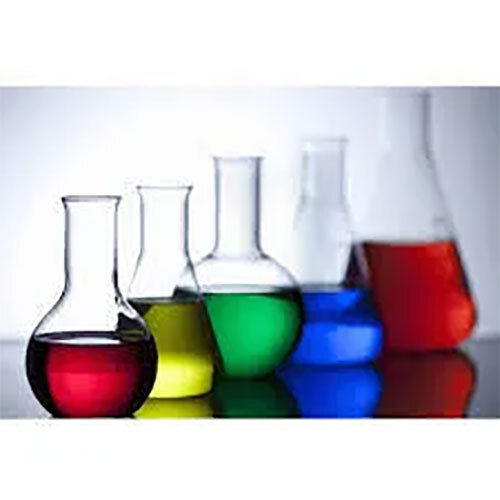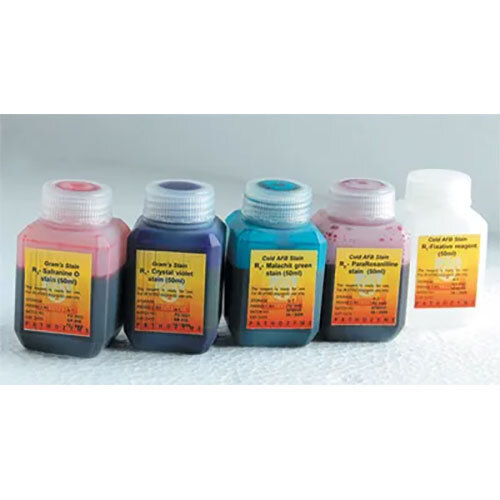Biological Stains
Price 80 INR/ Kilograms
Biological Stains Specification
- Flash Point
- Non-flammable / Not applicable
- Boiling point
- Not applicable for most biological stains
- Shelf Life
- 3-5 Years (when stored properly)
- Density
- 1.5 Gram per cubic centimeter(g/cm3)
- Ph Level
- Typically 5.5 - 7.5
- Molecular Weight
- Varies (depending on stain)
- Packaging Type
- HDPE bottle, Glass bottle, Sealed pouch
- Molecular Formula
- Varies (specific to individual stain)
- Storage Instructions
- Store in cool, dry place, protected from light
- Size
- 10 g, 25 g, 50 g, 100 g, 500 g
- Purity
- >98%
- CAS No
- Various (Dependent on dye/stain)
- Melting Point
- Specific to compound (typically 200-260C)
- Physical State
- Solid
- Usage
- Routine laboratory staining
- Grade
- Laboratory Grade
- Type
- Biological Stain
- Application
- Microscopy, Histology, Cytology, Bacteriology
- Appearance
- Powder/Crystalline Solid
- Purity(%)
- >98%
Biological Stains Trade Information
- Minimum Order Quantity
- 1 Kilograms
- Supply Ability
- 50000 Kilograms, , Per Week
- Delivery Time
- 3-7 Days
- Main Export Market(s)
- Middle East, Australia, Western Europe, North America, Eastern Europe, Asia, Central America, South America
About Biological Stains
Biological Stains are the colorants that find usage for biological reagents and biological stains. As leading name in this area, we ensure customers get quality dyes that can be made available with support of BSC certification. These are used in medicine and biological research laboratories for highlighting structures in biological tissues so as to view them more conveniently with support of microscopes.
The stains can be used for examining cell populations, organelles within individual cells and others. With consistent quality delivered each time, these in-stock products can be made immediately available.
Safranine O Stains:
Safranin O is the cationic dye that finds usage in medical field for staining acidic proteoglycan that are present in cartilage tissues and work as indicator cell chondrogenesis. The Safranin O stain is available in powder form which makes it easily dissolved in de-ionized water for making staining solution. When bound to glycosaminoglycan, Safranin O shows orange-red color.
MOQ 50kg :
| Specification | |
|---|---|
| Chemical Name | 3, 7-diamino-2,8-dimethyl-5-phenyl-phenazinium chloride |
| C.I.No. | 50240 |
| C.I.Genetic Name | Basic Red 2 |
| C.A.S. NO | 477-73-6 |
| Chemical Formula | C20H19ClN4 |
| Molecular Weight | 350.85 gm/mole |
| Dye Content (Spectrophotometry) | =>98% |
| Absorption Max (50% Ethanol) | = 530 - 534 nm |
| Absorptivity (A1%/1cm., in 50% Ethanol) | = > 1425 |
| Loss On Drying (110° c) | = < 4% |
| Powder Appearance | Crystal greenish |
Diethyl Safranine:
Diethyl Safranine finds application in cytology and histology fields where it is used as counter stain in some of the staining procedures including coloring of all cell nuclei in red color. Further, it is also suitable for detection of mucin, mast cell granules and cartilage.
MOQ 50kg :
| Specification | |
|---|---|
| Chemical Name | 3-Amino-7-(diethylamino)-5-Phenyl Phenazinium Chloride. |
| C.I.No. | 50240 |
| C.I.Genetic Name | Basic Red 2 |
| C.A.S. NO | 4569-86-2 |
| Chemical Formula | C22H23N4CI |
| Molecular Weight | 378.91 gm/mole |
| Dye Content (Spectrophotometry) | =>80% |
| Absorption Max (50% Ethanol) | = 552 - 557 nm |
| Absorptivity (A1%/1cm., in 50% Ethanol) | = > 935 |
| Loss On Drying (110° c) | = < 5% |
High Purity and Safety Assurance
Our biological stains maintain a purity greater than 98% and feature extremely low lead content and microbial contamination. They are non-toxic for standard laboratory procedures and emit no or mild odor, making them safe and pleasant to use. Comprehensive compliance with international and pharmacopeia standards further ensures reliable results in critical applications.
Versatile Applications Across Life Sciences
These stains are extensively used in microscopy, histology, cytology, and bacteriology. Their solubility in water and alcohol allows for seamless integration into a variety of staining protocols. Suitable for both teaching and research laboratories, they support precise visualization of cells, tissues, and microorganisms.
Convenient Storage and User-Friendly Packaging
Packaged in dense, airtight HDPE bottles, glass containers, or sealed pouches, biological stains are protected from moisture and light, preserving integrity. With multiple pack sizes from 10 g to 500 g and a 3-5 year shelf life, users can select the quantity best suited to their workflow while ensuring minimal waste.
FAQs of Biological Stains:
Q: How should biological stains be stored for maximum shelf life?
A: Biological stains should be stored in a cool, dry place, protected from direct light. Proper storage in tightly sealed HDPE bottles or pouches helps maintain their quality and extends shelf life up to 35 years.Q: What is the recommended process for using these stains in laboratory applications?
A: Dissolve the biological stain in water or alcohol (solvent choice depends on specific stain instructions) to the required concentration. Always handle the stain using gloves and eye protection to prevent skin and eye irritation during preparation and application.Q: Where are these biological stains most commonly used?
A: These stains are essential in laboratories involved in microscopy, histology, cytology, and bacteriology. They aid in visualizing and differentiating cells, tissues, and microorganisms for teaching, research, and diagnostic purposes.Q: What are the benefits of using high-purity biological stains?
A: High-purity stains ensure reproducible and reliable staining results, minimize background noise, and reduce the risk of contamination. Their low toxicity and non-conductive nature make them safe and easy to use in various scientific workflows.Q: When should you refer to the Material Safety Data Sheet (MSDS) for these stains?
A: The MSDS should be consulted before handling any biological stain to review safety precautions, exposure limits, and first-aid measureseven though the product is non-toxic under standard laboratory use conditions.Q: Are these biological stains compatible with all laboratory solvents?
A: Yes, they are compatible with most laboratory-grade solvents, including water and alcohol, making them adaptable for a wide range of protocols as required by different staining procedures.

Price:
- 50
- 100
- 200
- 250
- 500
- 1000+
More Products in Biological Reagents Category
Stain and Indicators
Price 50 INR / Kilograms
Minimum Order Quantity : 100 Kilograms, ,
Physical State : Solid (powder or crystals)
Melting Point : Varies by compound (e.g., 190192C for Methylene Blue)
Density : . Gram per cubic centimeter(g/cm3)
Packaging Type : Plastic bottle, HDPE drum, glass bottle
 |
MEGHA INTERNATIONAL
All Rights Reserved.(Terms of Use) Developed and Managed by Infocom Network Private Limited. |
 English
English Spanish
Spanish French
French German
German Italian
Italian Chinese (Simplified)
Chinese (Simplified) Japanese
Japanese Korean
Korean Arabic
Arabic Portuguese
Portuguese
 Send Inquiry
Send Inquiry

